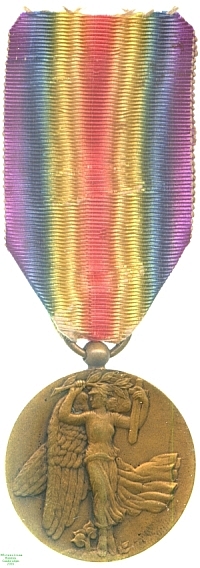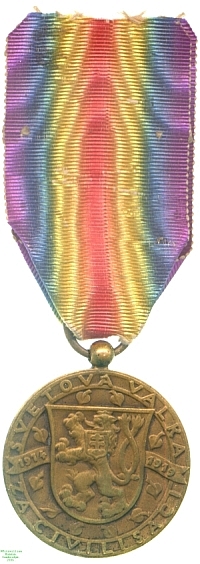
Obverse, Victory with a shortsword & an olive branch

Reverse, shield bearing an heraldic lion rampant with a crown and two tails, across a banner bearing the design inscription, all in a border

Obverse, Victory with a shortsword & an olive branch |

Reverse, shield bearing an heraldic lion rampant with a crown and two tails, across a banner bearing the design inscription, all in a border |
When the Great War of 1914-1918 had ended, there was a genuine feeling among the victorious Allies that their military efforts had been instrumental in preserving modern civilization, and this and the united spirit of the Alliance were commemorated in a combined issue of medals to those who had seen active service during the conflict. 13 nations in all issued a variety of this medal; all shared the rainbow ribbon and suspension, and all but the Japanese, who lacked a comparable symbolic figure, used a form of Victory on the obverse and a legend on the reverse.
This is the issue by the then-new Czecho-Slovak Republic, freshly constituted from territories of the dismantled Austro-Hungarian Empire; it was created later than many of the other versions, due to the lead time involved in establishing the new government, and in the interim some Czech soldiers were awarded the Belgian version of the medal. Even once designed, availability was poor and recipients were permitted to wear unofficial copies made privately. As this example bears a different suspension from that of the official version, it is likely that it is such an unofficial issue.
As a new state in 1918, Czechoslovakia had not technically had any soldiers under arms during the Great War, but a Provisional Government had existed in Paris throughout hostilities and Czech and Slovakian troops had served alongside the French, Russian and Italian armies. These troops were those eligible for the medal, and the different fronts of engagement generated 10 different campaign clasps, none of which however this unofficial example bears. Lester Watson purchased it from the London dealers Baldwin at some point before 1928.
The Museum is grateful to Mr Sawyer Rank for his information on this medal.